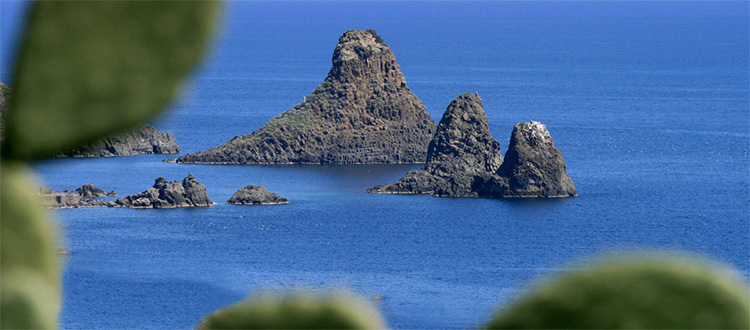Cyclops Riviera
The Riviera of the Cyclops
Acireale was already known in Roman times as a spa town. Its thermal baths are still in use, and attended by a number of regular visitors. The original town was destroyed by the earthquake of 1693. It was later built as we see it today: magnificent buildings in a rich baroque style, with a beautiful central square, which make it an interesting place to visit.
North of the city the coastline has been literally shaped by Mount Etna. Its lava flows have created over the centuries twisted rock formations and steep cliffs standing guard over coves with clear waters. One coast that stetches from Aci Castello to Acireale is the Riviera of the Cyclops. An evocative name to which are linked some famous Homeric myths, like the one attributing the birth of 8 spectacular cliffs of the Cyclops to Polyphemus who, blinded, snatched these rocks away from Mount Etna and hurled them against Ulysses and his comrades as they fled.
The Riviera of the Cyclops and Acireale
The small town is now right on the lava flow that destroyed the city in the late seventeenth century. A natural terrace with densely packed lemon groves looks straight down onto the sea. From the public gardens of Villa Belvedere, at the north edge of the town, you have the best view of the Riviera and Mount Etna. The Cathedral is a beautiful baroque building that has the distinction of having two spires covered with ceramic tiles and a beautiful Gothic façade. In the same square, or piazza, there is the Town Hall, while in Piazza San Domenico Palace there is Palazzo Musumeci, another fine example of Sicilian baroque. Acireale is known for its grand carnival, one of the finest festivals in Sicily, and is also one of the few places where the traditional puppet theater is still alive.
The Cyclops or Lemon Riviera
The distinctive feature of The Cyclops Riviera is its lava coast. Created by the many eruptions of Etna, and which looks onto a deep blue sea with the clearest of waters. The coastline warps close to Acireale. It then reaches a height of 120 meters above the sea, taking the name of Timpa. Then it gradually descends again. Always with its rough blackish appearance. It is called the Lemon Riviera because of the extraordinary spectacle offered by the lush citrus groves visible from the roadside.



